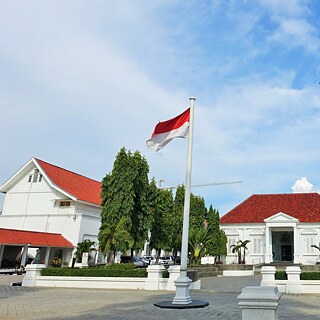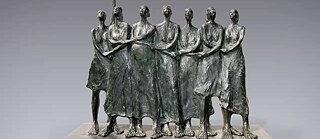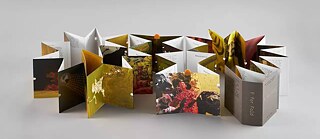Artworks & Archives
Ary “Jimged” Sendy - Traces of Home (2010)
Jimged documented the removal of people from their lands as a result of this land clearing for Jakarta’s Eastern Flood Canal. This photographic series showed the impact of this land clearing process on eleven subdistrics in East Jakarta and two subdistricts in North Jakarta.
Bruce Nauman - Body Pressure (1974)
This work consists of descriptions and instructions for a scene where the audience is encouraged to represent the idea of displacement as has been experienced by people in numerous public spaces.
Danarto - Si Hitam dan Si Putih (1963)
Through this painting, Danarto reflects on universal values concerning the struggle between good and evil as well as how many other people become victims of this struggle.
Heinrich Vogeler
Heinrich Vogeler is associated with the development of the Jugendstil (youth style) that was prominent during the early part of the 20th century. Vogeler’s works used strong lines and representations of workers, which were an adoption of a visual approach used in posters and Soviet imagery.
Kustiyah - Torso (1960)
This painting is a double portrait. Kustiyah creates a painting of her torso, created by husband Edhi Sunarso. By painting what has been ‘drawn’ by another person, Kustiyah expresses how she views herself as well as how she conceives Edhi’s gaze towards her.
Nguyễn Trinh Thi - Unsubtitled (2010-2013)
Through this work, Trinh Thi voices her criticism of the surveillance and intimidation of artists in Vietnam. Unsubtitled, through its political relevance, occupies an important position in the development of contemporary art in Vietnam.
Pacita Abad - Kumbakarna (1986)
In this trapunto painting, Pacita features Kumbakarna, brother of Rahwana, a main antagonistic giant in the epic of Ramayana. In her works, Pacita adapts traditional forms of expressions by exploring her inner self and recompose them as her personal expressions.
Öyvind Fahlström - Mao-Hope March (1966)
The video Mao-Hope March shows a demonstration in New York which was co-ordinated by Öyvind Fahlström on 1st September 1966. Bob Fass, a radio broadcaster, invited passersby to make their comments on the demonstration. Then, Fass would ask, “are you happy?” The answers were frequently casual and humorous and contrasted with the political tension of the late 1960s in the US caused by the Vietnam war.
Rusli - Bunga (1956)
Through using thin and thick brush strokes, which are occasionally transparent, and with bright colours and leaving much empty space, Rusli’s works follow the styles of traditional Japanese and Chinese paintings. A typical example of his works, includes Bunga (1956) which was made using water colours.
Semsar Siahaan
Unlike many works by artists who were associated with LEKRA, which mainly focused on one object or scene, Semsar’s paintings are close with the practice of socialist realism which was present in Eastern Europe, which often connected many events into one pictorial field.
Walter Spies
The painting, Das Karussell, was painted by Walter Spies five years before he moved to Bali in 1927. In contrast to the paintings of Bali’s natural environment htat he would later become known for, this painting shows a busy scene at a fair with a carousel as its focus.
Wilfredo Lam - Les Noces
In Les Noces, Wilfredo Lam plays with form. The painting is filled with figures which merge into human form, animals and plants. The faces, hands and legs are seen to be holding on or uniting with forms such as swords, candelabras, a crescent moon, a horse shoe, spears and wheels. Some of these objects come out from the painting, creating a disturbing, violent and ecstatic scene.
Wilfredo Lam - El Tercer Mundo
This painting is an expression of Wilfredo’s care for his homeland. Even though he lived in Europe after the coup d’etat in 1952, Wilfredo continued to follow news of the struggle of the Cuban people against the Fulgencio Batista dictatorship.






